Political cartoonists and Despots
Two stories have dominated the news agenda in 2023: the coronation of King Charles III and the continuing war in Ukraine. In last year’s anthology I wrote about the monarchy. Sadly, a week after the book had gone to the printers, the Queen died. In 2023, eighteen months on from the launch of Vladimir Putin’s invasion of Ukraine, I have decided to see what happens if I write about despots.
Monarchs and despots alike have attracted the attention of Britain’s greatest cartoonists for two centuries or more but, whereas kings and queens have, for the most part, been treated with a fair degree of respect, tyrants have without exception been savaged. And they haven’t liked it. Napoleon Bonaparte, Kaiser Wilhelm II, Benito Mussolini, Adolf Hitler – to name just a few – may have sought to present themselves as men of iron, but all proved to be thin-skinned, insecure, vainglorious ninnies when confronted by drawings that caricatured or ridiculed them. The same holds true today.
Napoleon Bonaparte was the first dictator to experience the pointy end of the political cartoonist’s pen, when he was targeted by the father of the modern political cartoon, James Gillray. The French emperor regarded himself as a ‘great man’ of history. Gillray saw him rather differently, invariably depicting him as ‘Little Boney’, a vertically challenged upstart. This diminutive character first appeared in a cartoon of January 1803 – German nonchalence [sic] - or - the vexation of little Boney – but arguably achieved cartoon immortality in Maniac- ravings - or - little Boney in a strong fit, published just three months later, shortly after the breakdown of the Treaty of Amiens, which had briefly established peace between England and France. Here Little Boney is shown stamping his feet in a childish rage, cursing the British press and Parliament and threatening invasion – a broken globe at his feet symbolising the destructive force Gillray believed him to represent. As the threat the emperor posed to Britain grew ever greater, so in Gillray’s cartoons he became ever smaller and more infantile: a child too big for his boots, weighed down by an increasingly oversized bicorn hat, enormous scabbard and immense spurs. Other British cartoonists followed suit, with Isaac Cruikshank, for example, starting to render Napoleon at half the height of his wife and troops.
In reality, the victor of many battles stood at around 5 feet 7 inches tall – about par for men of his time. Thanks primarily to Gillray, however, the British public came to believe that the emperor really was as diminutive as the cartoonists made him out to be. It is thanks to their work that the label ‘Napoleon complex’ is now used to talk about the belief that short men seek to compensate for their lack of stature through aggressive behaviour.
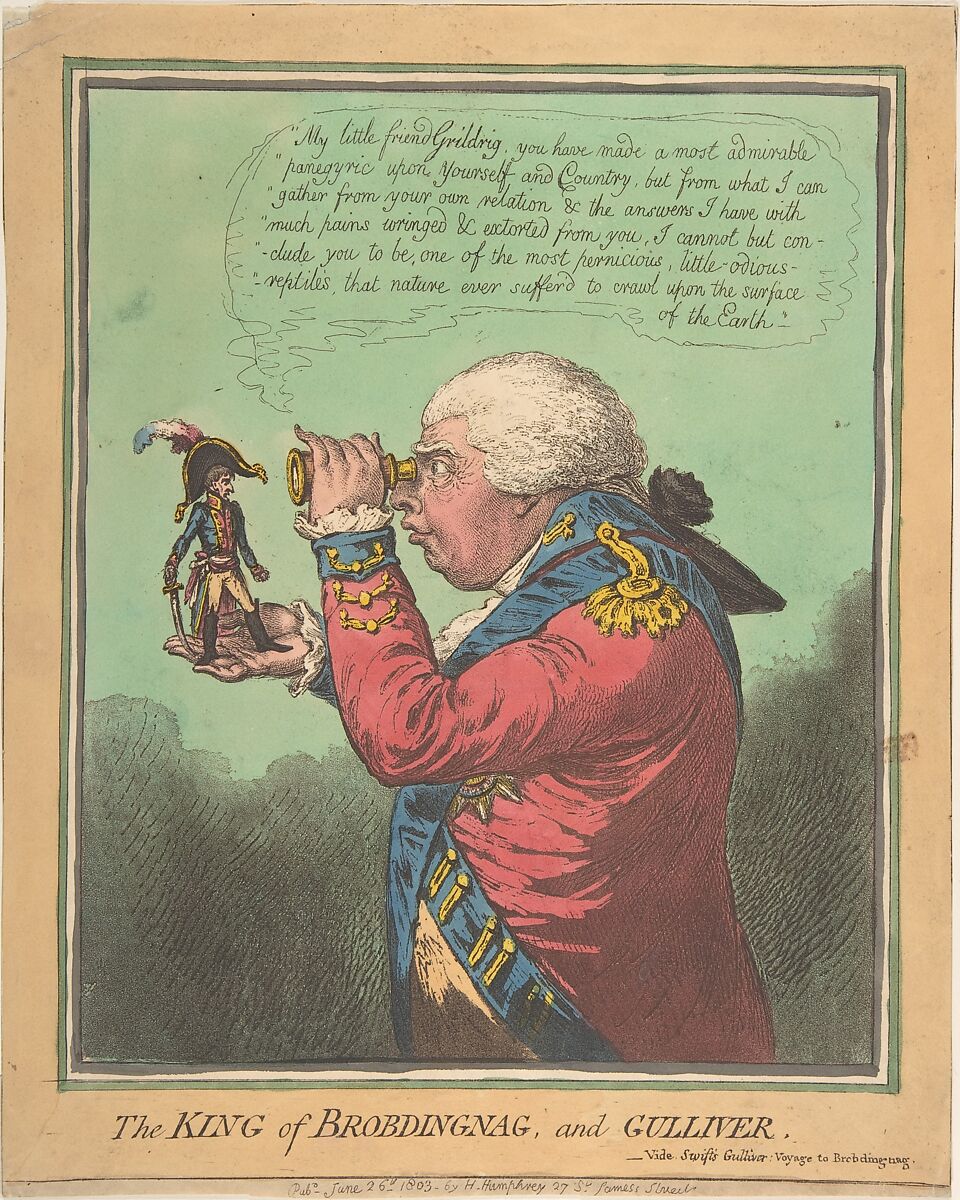 'Little Bony' James Gillray's 'The King of Brobdingnag, and Gulliver' (Napoléon Bonaparte; King George III)
'Little Bony' James Gillray's 'The King of Brobdingnag, and Gulliver' (Napoléon Bonaparte; King George III)
Napoleon failed to see the funny side. According to the historian Frederick Kagan, he viewed such slighting depictions of him as a ‘deliberate provocation’, and even went so far as to send a flurry of diplomatic notes across the English Channel demanding that the British government censor Gillray’s work. The cabinet, amused by his outrage, ignored him. Years later, when he was in exile on the isle of Elba, Napoleon was still smarting. He is supposed to have said that Gillray’s depictions of him had been ‘more damaging than a dozen generals’, and that they had ‘done more than all the armies of Europe to bring me down’. The image of Little Boney had done its work. At the other end of the nineteenth century, Kaiser Wilhelm II of Germany also found himself the target of British cartoonists, and proved to be even more sensitive about the way he was treated than Napoleon had been. Not yet 30 when he assumed the throne in 1888, he was invariably portrayed as a childish, impulsive and somewhat ridiculous figure, with his waxed moustache and love of theatrical uniforms. His decision to dismiss Germany’s long-standing senior statesman, Otto von Bismarck, in March 1890 prompted perhaps one of the most famous cartoons of all time: Sir John Tenniel’s Dropping the Pilot, in which Bismarck is the elderly captain forced to disembark from his ship with the Kaiser idly looking on.
The Kaiser had a keen interest in political cartoons. Indeed, he was a long-term subscriber to Punch, which had been a staple of the Prussian royal palaces since the late 1850s, when Wilhelm’s mother Victoria (eldest daughter of Queen Victoria of Great Britain) had married into the Prussian royal family. But there was only so much he could take. Matters came to a head in February 1892 when he gave an ill-advised, grandiose speech to the Brandenburg assembly in which he claimed to ‘be on the path that Heaven has laid out for me’. Faced with a Punch cartoon by Edward Linley Sambourne, entitled The Modern Alexander’s Feast, in which he was shown pompously toasting himself on the clouds of Mount Olympus, he wrote to his grandmother, Queen Victoria, seeking to persuade her to stop publication of the magazine. She explained that such a move was not ‘quite within [my] province’, although she did say that she was prepared to make it known to the magazine’s editor that critical cartoons of her grandson were damaging Anglo- German relations. Punch responded by publishing Wilful Wilhelm by Sambourne on 26 March 1892, which shows a childlike Kaiser angrily tearing at his copy of Punch with a smashed copy of Dropping the Pilot in the background. Amid the broken furniture around him is a broken globe – seemingly a nod to Gillray’s cartoon of ‘Little Boney’. The verse that accompanies the cartoon tauntingly reads: ‘My Wilful Wilhelm, you’ll not win / By dint of mere despotic din; / By kicking everybody over / In whom a critic you discover / Or shouting in your furious way, / “Oh! Take the nasty Punch away!” Within Germany the Kaiser could launch prosecutions of critical journalists for offences against the dignity of the sovereign (prosecutions against the press reached a high in Germany in the early 1890s). Faced with mockery from across the North Sea, the best he could do was to cancel his subscription to Punch. By 1904 he was also making sure that unflattering depictions of him were removed from any copies of the magazine that reached the German border. The constant trickle of anti-Kaiser cartoons turned into a flood when Britain declared war against Germany in 1914. Now he became the embodiment of the wicked Hun, depicted as either a monster or a farcical tyrant. In his anthology of his cartoons for the Daily Express entitled The Kaiser’s Kalendar for 1915 – Or the Dizzy Dream of Demented Willie Sidney Strube opted for the latter approach. Here ‘Little Willie’ happily dreams of dressing up as a Roman soldier and conquering London, his sausage dog in tow. In June I Personally Conduct My Own Opera at Covent Garden. In October I Play the ‘Loot’ over the Ruins of the Bank of England. Safely ensconced on the English side of the North Sea, Strube could do what he liked. Acutely aware, though, that the Kaiser’s reach extended to much of continental Europe, the Express thought it as well to print a warning on the back of the anthology: ‘The Daily Express warns purchasers not to send these Calendars to Troops at the Front, as the Germans have been known to inflict punishment on prisoners on whom they have found caricatures of the Kaiser.’
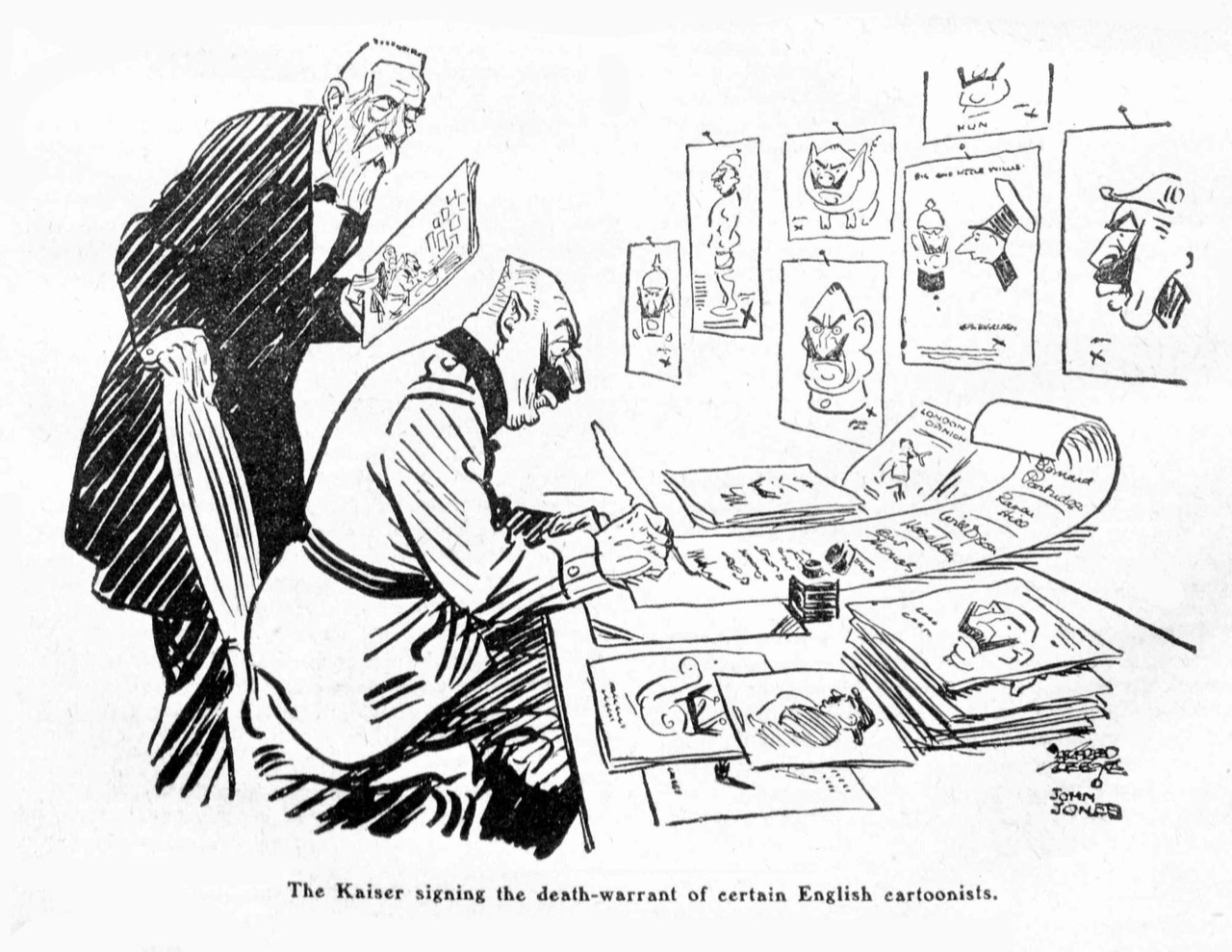 Alfred Leete on Kaiser Wilhelm's hatred for British political cartoonists.
Alfred Leete on Kaiser Wilhelm's hatred for British political cartoonists.
It wasn’t just British soldiers who were threatened; Wilhelm sought to menace the cartoonists, too. In June 1915 the German daily newspaper Deutsche Tageszeitung was instructed by the Kaiser to issue a warning to those cartoonists who drew for Punch that ‘when the day of reckoning arrives we shall know with whom we have to deal and how to deal with them.’ Punch’s response, later that month, was to published a cartoon by Leonard Raven-Hill entitled On the Black List, showing Mr Punch and Kaiser Wilhelm struggling over a hangman’s noose. As the Kaiser loses his grip, Mr Punch threatens him with his spear-like pen. The caption reads: ‘Kaiser: “I’m going to hang you.” / Punch: “Oh, you are, are you? Well, you don’t seem to know how the scene ends. It’s the hangman that gets hanged.”’ That the Kaiser was in deadly earnest when he made his threats is demonstrated by the fate of the Dutch cartoonist Louis Raemaekers, whose work was regularly published in the Amsterdam Telegraaf. The Dutch authorities were sufficiently worried by his anti-Kaiser stance as to confiscate his work on occasion when they thought he had overstepped the mark, their fear being that the notoriously sensitive German leader might be so outraged that he would order an attack on neutral Holland. For his part, the Kaiser so hated Raemaekers’ tendency to portray him as an ally of Satan that he got his government to put relentless pressure on the Dutch minister of foreign affairs to stop the errant cartoonist from drawing ‘anything that tends towards insulting the German Kaiser and the German army’. Raemaekers was eventually arrested for ‘endangering Holland’s neutrality’. When he was acquitted, the Kaiser put a bounty of 12,000 guilders on his head and anonymous death threats against his wife were made. In 1916, Raemaekers and his family fled to England. Here they were welcomed with open arms by British politicians and journalists, and Raemaekers embarked on a new career as cartoonist for newspapers such as the Daily Mail and The Times. British Prime Minister David Lloyd George was so impressed by his work that he persuaded him to tour the United States to drum up support for Britain and her allies. Henry Perry Robinson, who reported for The Times, later claimed that Raemaekers was one of six people – including statesmen and military leaders – who had a decisive influence on the outcome of the war. Theodore Roosevelt, former president of the United States, even said that Raemaekers’ ‘cartoons constitute the most powerful contribution made by neutrals to the cause of civilization in the World War’.
The fascist dictators who came to power in the following decades were as unamused by those who lampooned them as Napoleon and the Kaiser had been. Benito Mussolini, who had worked as a journalist and newspaper editor before he became the leader of Italy in 1922, regularly banned foreign publications and cartoonists that he felt treated him with insufficient respect and went so far as to refer to the Daily Dispatch cartoonist, George Butterworth, as a ‘dangerous enemy’. Arguably, he loathed the great David Low even more, banning sales in Italy of both the Evening Standard and the Manchester Guardian in the wake of the 1935 publication of a Low cartoon showing the Italian dictator being waved off to war in Abyssinia by Hitler, Joseph Goebbels and Hermann Goering, all dressed as women (The Girls He Left Behind Him) against a backdrop dominated by a gravestone on which appear the words ‘To the Abyssinian gamble – via Adowa?’ – a taunting reference to the great Italian defeat at Adowa in the First Italo-Ethiopian War of 1896.
Thereafter, David Low’s cartoons were never shown in the Italian press, except on the occasions when they were held up for mockery. His Suezcide, for example, which shows Mussolini in Roman armour shivering as he tests the temperature of the Suez Canal with his big toe, was reproduced in the Roman newspaper I l Tevere, alongside its own cartoon of John Bull, the personification of the British common man, floundering in the waters of the canal. The banner caption reads: ‘Our answer to the degraded Low of the Evening Standard.’ (Interestingly, the Nazis adopted a similar approach to cartoons critical of them. Hitler’s foreign press secretary, Harvard- educated Ernst ‘Putzi’ Hanfstaengl, was the genius behind an unusual and very successful book, Hitler in der Karikatur der Welt / Tat gegen Tinte [Hitler in the World’s Cartoons / Facts versus Ink], which turned critical cartoons back on the cartoonists by pointing One regular feature of Low’s cartoons proved a particular irritant for Mussolini: a dog Low elected to call ‘Musso’. Eventually, an official at the Italian embassy in London was ordered to contact the cartoonist in order to convey ‘the regrets of the entire Italian people at the desecration of this exalted surname’. The official (described by Low as ‘excited’) then ‘requested – nay, demanded – that in the interests of international concord the dog be rechristened’. Low affected to be astonished. There were, he informed the diplomat, probably 500 Mussolinis in the Rome telephone book and certainly two in London. It was a coincidence that Il Duce and his dog happened to share the same name. And if the official was seriously suggesting that Musso should be renamed, then what should be done about dogs bearing names of other celebrated Romans, such as Caesar and Nero?
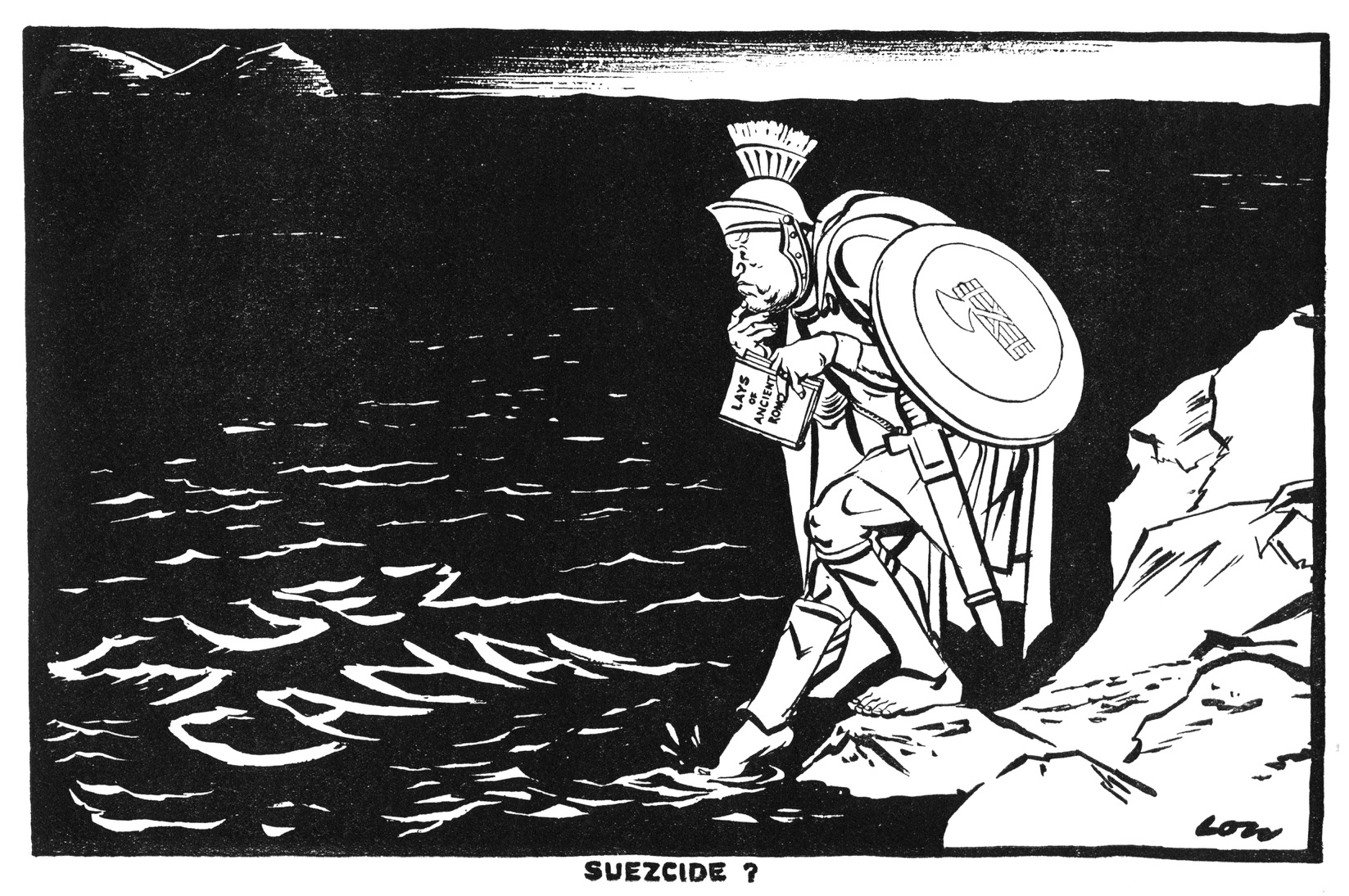 Benito Mussolini hated David Low's depiction of him.
Benito Mussolini hated David Low's depiction of him.
Rather surprisingly, Mussolini’s German counterpart, Adolf Hitler (himself an artist of sorts), started out as a David Low fan (he even requested a couple of originals from the cartoonist, although nothing came of it). But this was because he wrongly assumed that anyone who lampooned British politicians as regularly as Low did must be opposed to the system those politicians represented. Once he was in power, however, Hitler’s attitude to cartoonists in general, and Low in particular, swiftly changed. He loathed a cartoon Sidney Strube produced during the Berlin Olympics in 1936 so much that he had all that day’s copies of the Daily Express confiscated on arrival in Germany. On another occasion in November 1938, the German legation in Luxembourg brought a case against a left-wing magazine, Escher Tageblatt and its editor, Hubert- Clément, for publishing a cartoon that showed the Führer in ‘a state of violent exacerbation while making a speech’. Clément insisted that he had no intention of insulting Hitler and, when the Germans realised that the publicity surrounding the case threatened to make the cartoon universally known, they let the case drop.
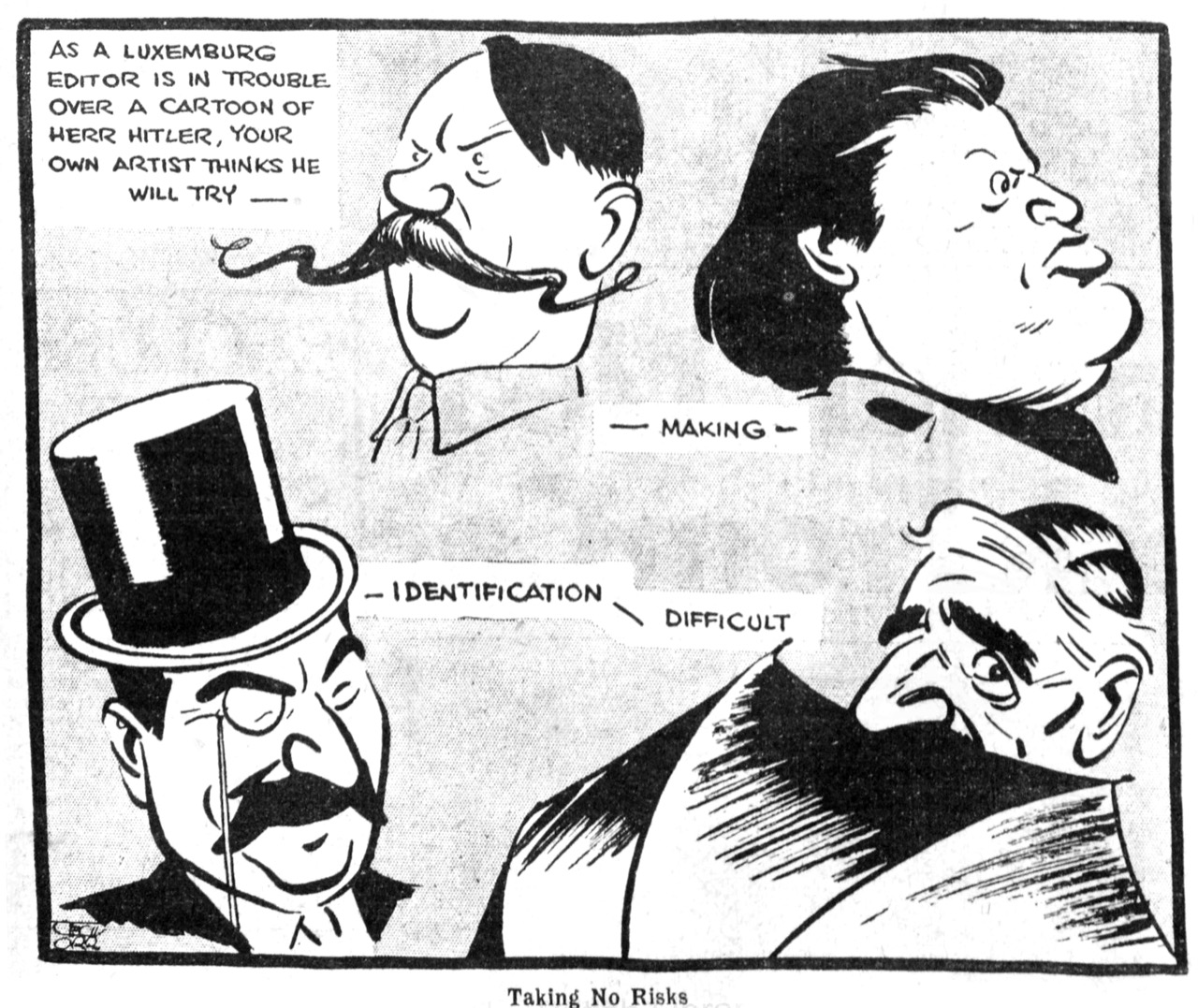 Cecil Orr on a dutch cartoonist being sued by the Nazis for his depiction of Adolf Hitler.
Cecil Orr on a dutch cartoonist being sued by the Nazis for his depiction of Adolf Hitler.
Thereafter, the leaders of the Nazi regime adopted much the same approach to criticism as the Kaiser had done: they claimed that it was damaging Anglo-German relations. Germany’s minister of propaganda, Joseph Goebbels, said as much to Britain’s foreign secretary, Lord Halifax, in 1937 when he explained just how sensitive Hitler was to criticism in the British press (he singled out David Low, in particular). At the end of the meeting Halifax promised that ‘the Government would do everything in its power to induce the London Press to avoid unnecessary offence’ and, once back in England, duly got in touch with those newspapers whose cartoonists were causing trouble. As he confirmed in a letter to the then British ambassador in Berlin, Sir Nevile Henderson: ‘I am hoping to see the Daily Herald and Daily News controlling powers myself.’ He conceded, however, that ‘I haven’t as yet devised any approach that is satisfactory to Low, who draws the pictures in the Evening Standard, and these I expect are the most troublesome of any.’ In the end, the foreign secretary decided to make a direct approach to the Evening Standard’s manager, Mike Wardell, and ask him if he could get Low to restrain himself a bit. ‘You cannot imagine the frenzy that these cartoons cause,’ he said. ‘As soon as a copy of the Evening Standard arrives, it is pounced on for Low’s cartoon and, if it is of Hitler, as it generally is, telephones buzz, tempers rise, fevers mount, and the whole governmental system of Germany is in uproar. It has hardly subsided before the next one arrives.’ Wardell’s response was to say that he could not control Low even if he wanted to, nor could Lord Beaverbrook, the proprietor of the Evening Standard. Low’s contract gave him complete creative control over his cartoons, and the newspaper could refuse to publish them only if they were obscene or libellous. Wardell went on to suggest that Halifax might be more effective if he were to talk to Low face to face. Halifax agreed and the meeting with the cartoonist took place. Low later described how the conversation went:
Once a week Hitler had my cartoons brought out and laid on his desk in front of him, and he finished always with an explosion. That he was extremely sore; his vanity was badly touched. He really bit the carpet . . . So the Foreign Secretary asked me to modify my criticism, in order that a better chance could be had for making friendly relations. I didn’t want to start World War II. I said that I thought it was my duty, as a pressman, to speak the truth and I think this man’s awful, but in view of the situation, I would be good. And so I was good,’ he concluded, ‘for about three weeks. Then Hitler walked into Austria.’
After Germany invaded Poland in 1939, the gloves came off on both sides. British cartoonists became more savage. The Nazis became more threatening. When, in December 1939, three months after the Second World War had broken out, Philip Zec drew a cartoon for the Daily Mirror showing an isolated Hitler eating Christmas dinner alone, the response from Berlin was not a diplomatic protest but a death threat. As Zec recalled: ‘Some days later, we were sent a copy of a German newspaper in which they described me as “this filthy lying hyena scum”. The article went on to say that amongst the first dozen people to be shot when the Germans arrived in London would be me.’ After the war Zec, along with Low, Leslie Illingworth and just about every Fleet Street cartoonist, discovered that their names featured in the Nazi Black Book – a secret list, produced by the SS, of the people to be immediately arrested if Germany invaded Britain.
Given that Goebbels once observed that ‘a joke ceases to be a joke when it relates to the Nazi regime and its leaders,’ it is hard to conceive of any cartoon that would not have caused offence in Germany – nor in Italy where, according to Low, an official once told him: ‘If we allowed the cartoonist any licence here, he would be making jokes about Fascism, and that would never do.’ The British sense of humour didn’t exactly help: quite simply, European fascist leaders were bewildered by it. Sidney Strube argued that they couldn’t understand how, ‘[a]s they goose-stepped along to their downfall, we in this country laughed our way through our difficulties. The flooded air raid shelter, the snorer, the shelter bore, “my bomb story”, spam, sand in the desert and mud in Italy, all these things cartoonists turned to a smile,’ he went on. He also observed that the ‘Nazis couldn’t laugh at themselves, and at the end they were afraid to laugh at all.’ Hitler once instructed Joseph Goebbels and his psychiatrists to study a Bruce Bairnsfather First World War cartoon to establish what made the British laugh, the cartoon in question being the famous one of a couple of Tommies standing in a shell-hole with one saying to the other: ‘Well, if you knows of a better ’ole, go to it’. The sardonic tone of the cartoon was completely lost on Goebbels, who informed the Führer that the gag revolved around the fact that ‘[t]he soldier is standing in a big shell-hole . . . and what he means is that this is a German shell-hole and that we make the biggest shell-holes in the world.’
That cartoonists are so good at getting under the skin of despots should come as no surprise. Tyrants desperately want to be taken seriously. Cartoonists refuse to oblige. ‘I have learned from experience,’ wrote David Low, ‘that, in the bluff and counterbluff of world politics, to draw a hostile war lord as a horrible monster is to play his game. What he doesn’t like is being shown as a silly ass.’ In much the same way, Steve Bell, cartoonist for the Guardian, has observed that the role of the political cartoonist is akin to the little boy in the story ‘The Emperor’s New Clothes’: ‘We’re the ones that point and say, “Look! He hasn’t got any clothes on!” Somebody has to point out sometimes that this is a lot of nonsense. The cartoonist does that and makes everybody laugh. That’s the one thing totalitarians, tyrants and despots of all types cannot stand.
Today’s cartoonists draw on many of the same ridiculing techniques as their forebears did. They mock despots’ physiques. They laugh at their egos. When it comes to portraying Vladimir Putin, for example, many cartoonists follow in Gillray’s footsteps by zeroing in on his perceived lack of inches. Peter Brookes of The Times says that he enjoys ‘demeaning [Putin] by [reference to] his short stature’. Patrick Blower of the Daily Telegraph asserts that harping on about Putin’s lack of height ‘offers the constant chance to depict him as simultaneously macho man and weakling’. Kevin Kallaugher mocks Putin’s stature and also the aggression he believes lurks in Putin’s facial features: ‘Putin has a funky stubby nose leading to an angry little mouth. The key to any caricature of Putin is his angry KGB eyes.’ Christian Adams of the Evening Standard, meanwhile likes to subvert Putin’s testosterone-fuelled persona by drawing him with a pot belly in the hope that it would upset him if he were to see it. Independent cartoonist Brian Adcock seeks to humiliate him, too: ‘Putin has such a deluded sense of self, he’s a complete narcissist. He thinks he’s such a tough guy riding bare chested on horseback. It is so much fun to poke fun at that. I like to try and humiliate him as much as possible, prick that ridiculous ego. I like to draw him with flabby man-boobs and really long nipples. He doesn’t have long nipples but I just like to draw him that way as I think if he ever saw it, it would really annoy him.’
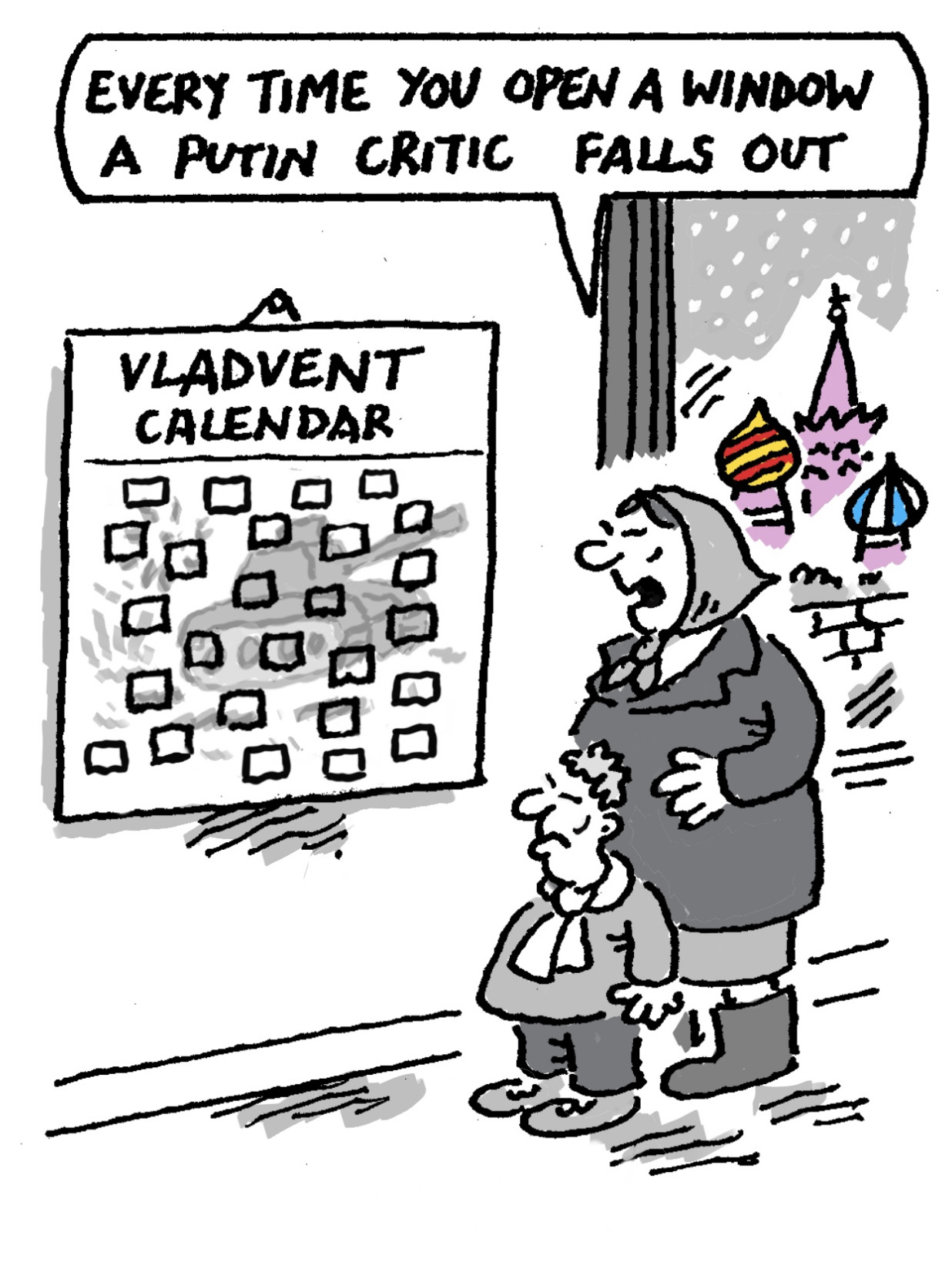 Nick Newman on life under Putin.
Nick Newman on life under Putin.
Tyrants’ lack of anything approaching nuance is also a gift for cartoonists. According to Rebecca Hendin, cartoonist for the Guardian and New Statesman, ‘All cartoonists relish drawing despots, as they are generally ready-made cartoon characters, dealing in absolutes, in black and white and leave little need for exaggeration.’ Brian Adcock looks forward to drawing despots because he gets ‘to draw and comment on the most hideous people on the planet, a chance to expose them to the world’. Steve Bright of the Sun believes cartoonists enjoy drawing despots in the same way actors like playing baddies: ‘They’re so much more fun to take on, and cathartic to draw.’
Other contemporary authoritarian leaders receive similar treatment. Xi Jinping of China is regularly depicted by Peter Brookes as having ridiculous hair. For Andy Davey ‘the stream of implausible Stalinist lunatics that North Korea provides, especially the mad haircuts’ provides the same level of inspiration. Christian Adams further notes that Kim Jong-un is ‘very, very short’ and depicts him thus in the hope that ‘he would hate that’.
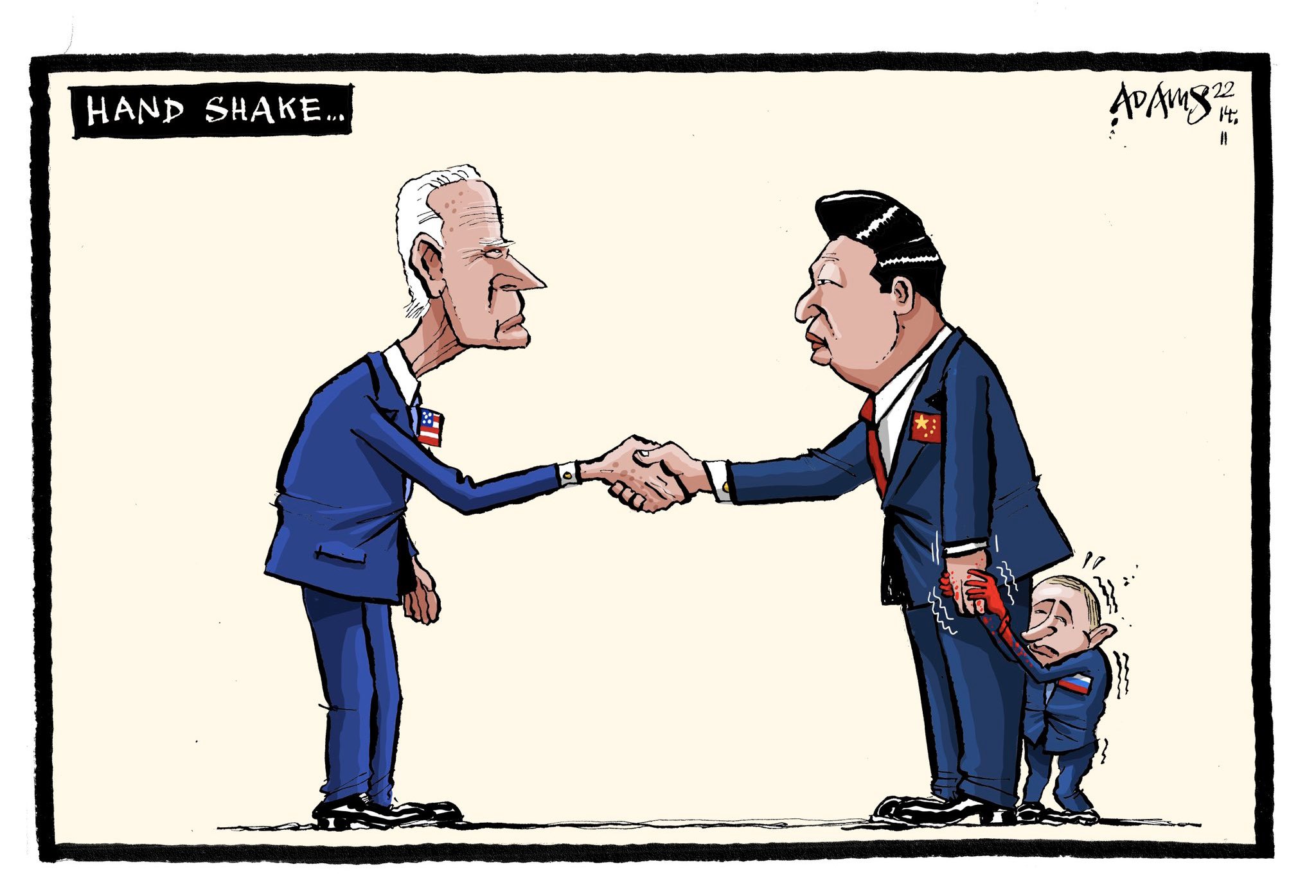 Christian Adams enjoys making fun of Putin's lack of height.
Christian Adams enjoys making fun of Putin's lack of height.
Whether or not the former leader of the Free World can be described as a would-be despot is a matter of debate, but it is worth noting that cartoonists have treated Donald Trump much as they have treated the Putins, Xis and Kims of this world. Pocket cartoonist Nick Newman believes that, ‘as a purely comic despot, Trump has to be my favourite, because his despotism, or attempts at despotism if that’s what you’d call it, failed.’ Henny Beaumont (cartoonist for the Guardian) argues that ‘You can have such fun with his ridiculous yellow hair, orange skin and pouty mouth. It amused me to draw his long red tie as a snake and when he was defeated, I drew him as a big orange puddle.’ Rebecca Hendin also has a soft spot for Trump, but for a rather different reason: ‘He’s easy to draw and I’m a sucker for an easy drawing.’
As a rule, even extreme savaging of the more autocratic of today’s world leaders causes little controversy. As Peter Brookes puts it: ‘There is no opposition to your depiction of a despot as everyone tends to agree with you.’ According to Andy Davy, ‘They’re an easy target. I often feel a little like a cop-out when drawing them because they are such universal hate-figures and nobody is going to disagree with my ridiculing of them.’ Patrick Blower concurs: ‘Tyrants are unambiguous “baddies”, which is always useful for cartoonists.’ This lack of ambiguity can create problems for pocket cartoonists, though. Pockets are, in essence, topical gags that are supposed to be jovial and, as we know, dictators committing genocide is not exactly a laugh a minute. According to Nick Newman, ‘With despotism comes all the things you don’t want to think about, human rights abuses, war crimes etc., which make jokes for the pocket cartoonist well-nigh impossible. To be honest I’d rather despots didn’t exist.’ Steve Bell expresses a slightly different reservation, warning that cartoonists ‘should not trivialise despots by harping on about goodies and baddies and that “evil” Putin is responsible for all that is bad in the world’. Today’s authoritarian leaders are as unforgiving of mockery and criticism as those who came before them. As Steve Bright puts it: ‘I suspect you have to be fairly humourless to be an effective despot, and I imagine that being laughed at really gets up their despotic noses.’ Lampoons by non-native cartoonists may no longer cause the diplomatic incidents they once did (Peter Brookes for one believes that, ‘unlike previous dictators, [Putin] doesn’t seem to give a damn’), but local critics are rarely tolerated.
Mikhail Zlatkovsky offers a case in point. A leading Moscow cartoonist, he was allowed, early in his career, to draw Gorbachev and then Yeltsin (he had also drawn Stalin, although the cartoon that he drew of him as a teenager in 1959 was not published until 1988). When Putin was Yeltsin’s deputy, Zlatkovsky also drew him. However, the day after Putin’s inauguration in May 2000, Zlatkovsky’s editor came to see him after a visit to the Kremlin: ‘He said to me, “Misha, we’re not going to draw Putin anymore. The young lad is very sensitive,”’ recalled Zlatkovsky. From that day onwards, he, along with other Russian cartoonists, found it impossible to get a cartoon of Putin published unless it presented the leader in a heroic light. And as Putin gained a firmer grip on power, the number of taboo subjects increased: according to Zlatkovsky, ministers, Kremlin aides and top military brass all became off limits. One Guardian cartoonist told me that when he was in Moscow in 2016 on a British Council trip, his minder repeatedly told him to stop drawing cartoons of Putin on restaurant napkins lest it should catch the attention of eagle-eyed officials. These days, being a political cartoonist in Putin’s Russia means being a propagandist for the regime. Caricaturing Putin is forbidden and carries ever more significant risks; after Russia’s invasion of Ukraine it was ruled that cartoonists who produced the ‘wrong’ sort of cartoons could be found guilty of spreading ‘fake news’ and face up to 15 years in prison.
The fact that despots continue to be fearful of cartoons that mock them shows how important it is that they should still be drawn. Brian Adcock believes satire remains one of the best ways to get to an autocrat: ‘Laughing at the powerful, especially despots, is a brilliant way to try and bring them down to size.’ Nicola Jennings of the Guardian thinks satirising despots may make them a figure of fun but in doing so ‘it criticises their behaviour’. Andy Davey agrees that cartoons have a serious purpose, while also bringing much-needed relief to seriously depressing news: ‘I don’t think it trivialises their actions – well, no more than cartoons trivialise everything by the mildly humorous (“Horatian”) satirical style that dominates newspaper cartoons. I guess such tyrants deserve a colder, harder “Juvenalian” treatment but readers get fed up with serious stuff and look to the cartoon for some relief.’
The 2023 edition of Britain’s Best Political Cartoons proves that Patrick Blower was correct when he said that ‘the great privilege of living in a liberal democracy is that we can not only openly mock our own leaders but that of other nations too. When occasion demands, cartoonists can jettison the jokes to produce powerful visual commentary on the actions and crimes of tyrants.’ British cartoonists are, and have always been, unsurpassed when it comes to confronting and ridiculing despots. Of course, we all wish we could live in peace and harmony with benign political leaders who have their populace’s best interests at heart. Unfortunately this is often not the case. And so our finest practitioners will continue belittling these despotic tyrants who have metaphorical and often literal ‘blood on their hands’. As Rebecca Hendin says: ‘Life would be better with no despots. I’d rather draw a utopia filled with cats. But as long as despots are despoting, it seems like a good idea to draw them.’
 View Account
View Account